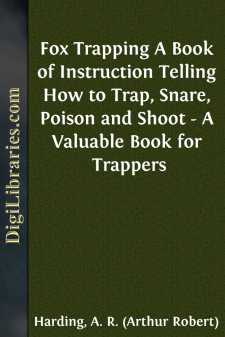Categories
- Antiques & Collectibles 13
- Architecture 36
- Art 48
- Bibles 22
- Biography & Autobiography 813
- Body, Mind & Spirit 142
- Business & Economics 28
- Children's Books 16
- Children's Fiction 13
- Computers 4
- Cooking 94
- Crafts & Hobbies 4
- Drama 346
- Education 46
- Family & Relationships 57
- Fiction 11829
- Games 19
- Gardening 17
- Health & Fitness 34
- History 1377
- House & Home 1
- Humor 147
- Juvenile Fiction 1873
- Juvenile Nonfiction 202
- Language Arts & Disciplines 88
- Law 16
- Literary Collections 686
- Literary Criticism 179
- Mathematics 13
- Medical 41
- Music 40
- Nature 179
- Non-Classifiable 1768
- Performing Arts 7
- Periodicals 1453
- Philosophy 64
- Photography 2
- Poetry 896
- Political Science 203
- Psychology 42
- Reference 154
- Religion 513
- Science 126
- Self-Help 84
- Social Science 81
- Sports & Recreation 34
- Study Aids 3
- Technology & Engineering 59
- Transportation 23
- Travel 463
- True Crime 29
Fox Trapping A Book of Instruction Telling How to Trap, Snare, Poison and Shoot - A Valuable Book for Trappers
Categories:
Description:
Excerpt
CHAPTER I.
GENERAL INFORMATION.
Foxes are found in all parts of America, but probably most numerous in the New England States and parts of Canada. The range of the red is from Virginia to Alaska; grey, Southern and Southwestern States; cross, Northern New Jersey to Manitoba; black, Alaska, and the territories several hundred miles to the South and East; swift, the prairies or Great Plains; white and blue, the Arctic Regions.
While their fur has been one of value for many, many years, and they have been hunted, trapped and snared, yet their numbers are holding up remarkably well owing to their shrewdness. While many tricks are claimed for foxes that they never did, yet they are very cunning animals and also fleet on foot.
In hilly and mountainous countries they travel much on the highest ground, and have regular "crossings," where the experienced hunter or trapper often makes a kill or catch.
Foxes are carnivorous--living on flesh. Their principal food consists of rabbits, squirrels, mice, birds, bugs, eggs, etc. In some places where the food named is not plenty they visit creeks, lakes and ponds hunting crabs and fish. While they prefer fresh meat, they take stale and even decayed meats in severe weather.
Most wild animals can be attracted a short distance by "scent" or "decoy," and the fox is one of them. Several good recipts for scent are given, but if there are no foxes in your neighborhood you can use all the "scents" and "decoys" you wish on a hundred traps all season without making a catch. There is no "decoy" that will attract a fox a mile, but there are some that are good. That many of the writers made good catches is bourn out by the various photographs, and in some instances by personal visits by the author to the trapper.
Foxes should not be trapped or shot until cold weather. In the states bordering on Canada about November 1st, while to the north they become prime sooner, while to the south they do not become prime until later.
The pelt should be cased, that is skinned without ripping, and drawn upon a board. Several tacks or small nails can be used to hold the skin in place. Leave on the board only two to five days, according to the weather. When removed, turn fur side out. In drying, keep in a cool shady place and free from smoke. The number caught and killed annually is not known, but of the various kinds--red, grey, cross, white, etc.--it is several hundred thousand.
ALMOST DRY ENOUGH TO TURN.
The following letters cover trapping and snaring pretty thoroughly, and all who read carefully and set their traps according to directions (if there are any foxes) will probably be successful. While the No. 2 Newhouse, which is a double spring, is known as the fox trap, the No. 1 1/2 single spring will hold the animal. We have known of several instances where fine "reds" were caught in a No. 1 trap. In those instances, however, the trap was fastened to a loose brush and every time the fox made a lunge the brush gave. In using the larger size, we advise using a brush or clog that will give with every pull or jump of the fox....








